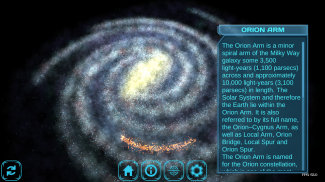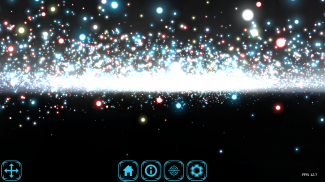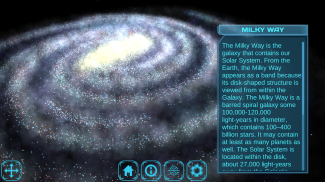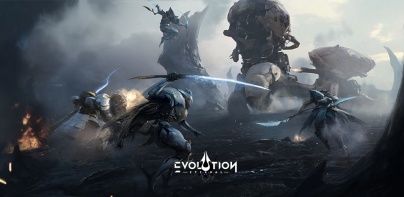










3D Galaxy Mappa

Descrizione di 3D Galaxy Mappa
★Caratteristiche ★
Un modello completamente in 3D della mappa Via Lattea - è possibileruotare, ingrandire e spostare la galassia in qualsiasi direzione.
Informazioni su tutte le armi conosciute (Far 3kpc, Vicino 3kpc, Norma-esterno, Orione, Perseo, Sagittario, scutum-Crux) e il Nucleo Galattico viene visualizzato quando l'utente tocca la rispettiva struttura.
Menu Opzioni ★ />
- Può modificare la popolazione stella (riducendo risultati in un aumento delle prestazioni FPS)
- Può mostrare un contatore FPS nell'angolo in basso a destra dello schermo
Informazioni ★ />
Questa è la versione mobile rinnovamento della mappa galassia dallahttp://www.3dgalaxymap.com/GalaxyIspirato dal concetto dell'artista NASA annotato dahttps://solarsystem.nasa.gov/multimedia/display.cfm?IM_ID=8083Attualmente contiene la prima scena - la scena Galaxy. I seguenti aggiornamenti principali sono programmati per essere rilasciato:
L'Settore Scena avrà oltre 140000 stelle da più cataloghi astronomici suddivisi in 10 settori cubo parsec.
L'Scene sistema si concede all'utente la possibilità di esplorare tutti i pianeti extrasolari scoperti finora, e il sistema solare con i suoi pianeti e pianeti nani: Mercurio, Venere, Terra, Marte, Cerere, Giove, Saturno, Nettuno e Plutone.
Parole chiave: galassia, astronomia, stella, carta, grafico, spazio, orion, via lattea, solare, sole, centro galattico, braccio a spirale
★Features★
A fully 3D model of the Milky Way Galaxy map - you canrotate, zoom and movethe galaxy in any direction.
Information about all the known arms (Far 3kpc, Near 3kpc, Norma-Outer, Orion, Perseus, Sagittarius, Scutum-Crux) and the Galactic Core is displayed when the user touches the respective structure.
★Options Menu★
- can modify the star population (reducing results in an increase in FPS performance)
- can show an FPS counter in the bottom right corner of the screen
★Information★
This is the mobile version revamp of the galaxy map fromhttp://www.3dgalaxymap.com/GalaxyInspired by the NASA annotated artist's concept fromhttps://solarsystem.nasa.gov/multimedia/display.cfm?IM_ID=8083Currently contains the first scene - the Galaxy Scene. The following major updates are programmed to be released:
TheSector Scenewill have over 140000 stars from multiple astronomical catalogs divided into 10 parsec cube sectors.
TheSystem Scenewill grant the user the possibility to explore all the exoplanets discovered so far, and the solar system with its planets and dwarf planets: Mercury, Venus, Earth, Mars, Ceres, Jupiter, Saturn, Neptune and Pluto.
Keywords: galaxy, astronomy, star, map, chart, space, orion, milky way, solar, sun, galactic center, spiral arm





























